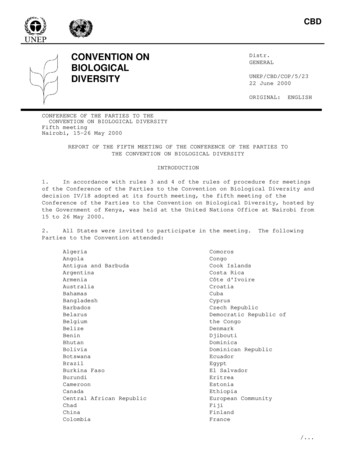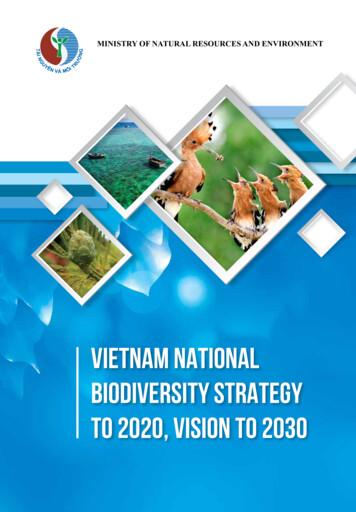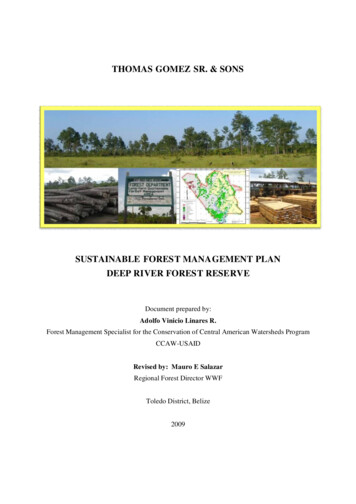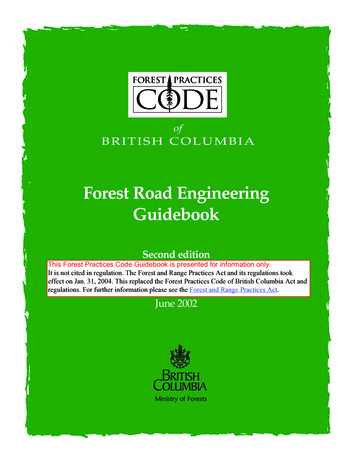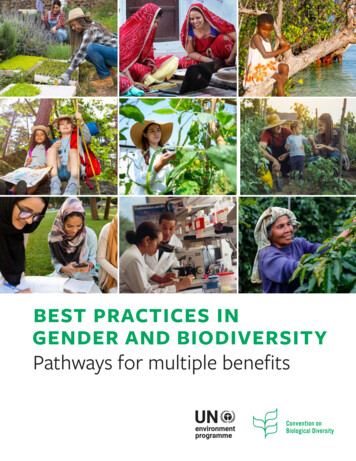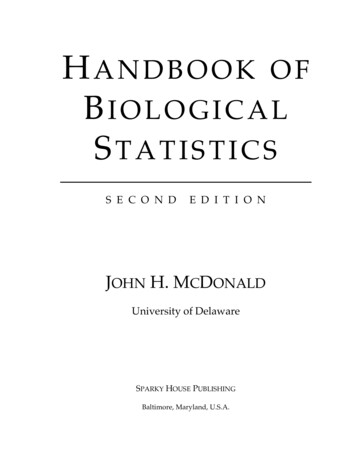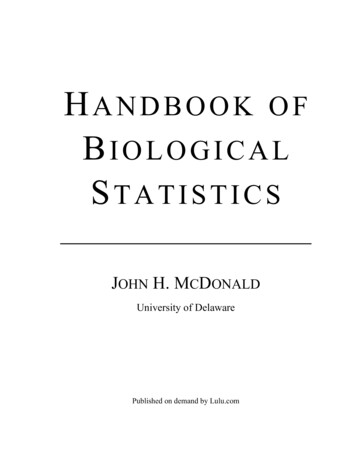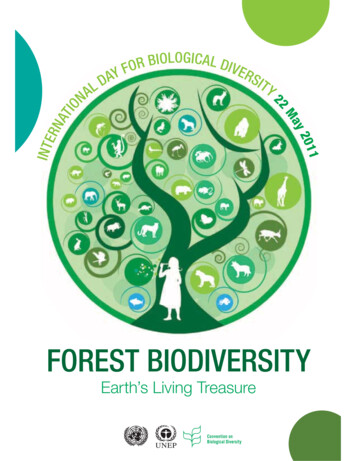
Transcription
01 1IN T ERNy2MaATIO22NAOLOGICAL DIBRIVERFOYASI TDLYFOREST BIODIVERSITYEarth’s Living Treasure
INTERNATIONAL DAY FOR BIOLOGICAL DIVERSITY22 May 2011FORESTBIODIVERSITYEarth’s Living Treasure
Published by the Secretariat of the Convention on Biological Diversity.ISBN: 92-9225-298-4Copyright 2010, Secretariat of the Convention on Biological Diversity.The designations employed and the presentation of material in this publication do not imply theexpression of any opinion whatsoever on the part of the Secretariat of the Convention on BiologicalDiversity concerning the legal status of any country, territory, city or area or of its authorities, orconcerning the delimitation of its frontiers or boundaries.The views reported in this publication do not necessarily representthose of the Convention on Biological Diversity.This publication may be reproduced for educational or non-profit purposes without special permissionfrom the copyright holders, provided acknowledgement of the source is made. The Secretariat of theConvention would appreciate receiving a copy of any publications that use this document as a source.Citation: Secretariat of the Convention on Biological Diversity (2010).Forest Biodiversity—Earth’s Living Treasure. Montreal, 48 pages.For further information, please contact:Secretariat of the Convention on Biological DiversityWorld Trade Centre413 St. Jacques Street, Suite 800Montreal, Quebec, Canada H2Y 1N9Phone: 1 (514) 288 2220Fax: 1 (514) 288 6588E-mail: secretariat@cbd.intWebsite: www.cbd.intDesign & typesetting: Em Dash DesignCover illustration: Cover illustration: Untitled, 2010. Aby Abraham, age 12. Qatar.1st place winner in the 11 to 15 years old category of the Young Hands Together for DiversityInternational Biodiversity Art Competition, 2010.Printed on Rolland Enviro100, which contains 100% recycled post-consumer fibre, is EcoLogo,Processed Chlorine Free and FSC Recycled certified and manufactured using biogas energy.
INTERNATIONAL DAY FORBIOLOGICAL DIVERSITY 2011:FOREST BIODIVERSITYJan L. McAlpine—Director of the UnitedNations Forum on ForestsForests contain some of our planet’s most vibrantecosystems, displaying a wondrous variety of birds,animals, and plants. Forests are the basis for morethan 5,000 products, from aromatic oil distilledfrom leaves to herbal medicines, fuel, food, furnitureand clothing; they prevent soil erosion and help toregulate the climate; they provide clean water; theyinspire us in art, research and religion; and they areessential to the survival and well-being of peopleeverywhere—all 7 billion of us.Yet, the world’s forests are facing immense pressures and challenges. Key findings from the GlobalForest Resources Assessment 2010 show that whiledeforestation has slowed somewhat in recent yearsas compared to the 1990s, it is still alarmingly high.Continued deforestation has resulted in carbonAhmed Djoghlaf—Executive Secretary,emissions, shortages in water and food supply,Convention on Biological Diversityand an unprecedented loss of biodiversity. But theworld is not standing idly by. Governments, international organisations and foreststakeholder groups are taking action—to find ways of conserving and sustainablymanaging forests for the benefit of present and future generations.This is why the United Nations declared 2011 as the International Year of Forests(Forests 2011), and why forests are the theme of the International Day for BiologicalINTERNATIONAL DAY FOR BIOLOGICAL DIVERSITY · Forest Biodiversity3
Diversity on 22 May 2011. In this special year, the United Nations Forum onForests (UNFF) and the Secretariat of the Convention on Biological Diversity(CBD) are working together to highlight the importance of forest biodiversityto humankind. The theme for Forests 2011 is “Forests for People”, celebratingof the central role of people in the management, conservation, and sustainabledevelopment of our world’s forests.This booklet aims to raise awareness of the threats and challenges faced byforests and to promote efforts for forest conservation and sustainable management. Maintaining the world’s rich forest biodiversity will help us combatthe climate crisis, alleviate poverty, support human health, and leave ourchildren and grandchildren the bountiful and beautiful legacy of living foreststhat we enjoy today. Clearly, no task could be more timely or important. Thenew Strategic Plan of the CBD aims to at least halve the rate of deforestation by 2020, and where possible bring it close to zero; restore 15 per cent ofdegraded forests; manage all forests sustainably; and increase the coverage ofprotected areas to 17 per cent. Achieving these ambitious targets will requiredecisive action and close collaboration at all levels. At UNFF and CBD, welook forward to working with the international community to ensure thatour constituencies are fully empowered to move towards a better future forforests and people.Jan L. McAlpineDirector, United Nations Forum on ForestsAhmed Djoghlaf,Executive Secretary,Convention on Biological Diversity4INTERNATIONAL DAY FOR BIOLOGICAL DIVERSITY · Forest Biodiversity
INTERNATIONALYEAR OF FORESTSThe United Nations proclaimed 22 May as theInternational Day for Biological Diversity to promote agreater understanding and awareness of biodiversity issues.The theme of the 2011 International Day for BiologicalDiversity is forest biodiversity. The Secretariat of theConvention on Biological Diversity (CBD Secretariat)encourages governments and civil society everywhere to organize activities andevents to celebrate this day, raise public awareness, showcase good practicesand inspire further actions for preserving forest biodiversity.How to get involvedThe CBD Secretariat encourages all Parties to the Convention and all organizations that deal with forest biodiversity to organize activities and events tocelebrate the International Day for Biological Diversity 2011. Resource materialis available on the websites of the member organizations of the CollaborativePartnership on Forests (see information at the end of this brochure), as wellas on the CBD website: www.cbd.int/idbResource material on forest biodiversity for schools, educators and studentsis available at http://greenwave.cbd.int or can be ordered at secretariat@cbd.intPlease inform the CBD Secretariat of your International Day for BiologicalDiversity activities by e-mail (secretariat@cbd.int) or fax: 1 514 288 6588,to ensure that information about your activity is posted on the CBD website.INTERNATIONAL DAY FOR BIOLOGICAL DIVERSITY · Forest Biodiversity5
TABLE OF CONTENTSWhat’s important about forests . . . . . . . . . . . . . . . . . . . . . . . . . . . . . . . . . . . . . . . . . . . . 8Key Facts . . . . . . . . . . . . . . . . . . . . . . . . . . . . . . . . . . . . . . . . . . . . . . . . . . . . . . . . . . . . . . . .10Introduction . . . . . . . . . . . . . . . . . . . . . . . . . . . . . . . . . . . . . . . . . . . . . . . . . . . . . . . . . . . . .12Mega-diverse forests . . . . . . . . . . . . . . . . . . . . . . . . . . . . . . . . . . . . . . . . . . . . . . . . .14Valuing forest biodiversity . . . . . . . . . . . . . . . . . . . . . . . . . . . . . . . . . . . . . . . . . . . . . . . . 16The Earth’s “natural capital” . . . . . . . . . . . . . . . . . . . . . . . . . . . . . . . . . . . . . . . . . .16“Insurance” against climate change . . . . . . . . . . . . . . . . . . . . . . . . . . . . . . . . . .19Support for people’s livelihoods . . . . . . . . . . . . . . . . . . . . . . . . . . . . . . . . . . . . . .21Forest genetic resources and the fair and equitable sharingof benefits . . . . . . . . . . . . . . . . . . . . . . . . . . . . . . . . . . . . . . . . . . . . . . . . . . . . . . . . .22Sustainable use: linking people and forests . . . . . . . . . . . . . . . . . . . . . . . . . . .24Threats and challenges . . . . . . . . . . . . . . . . . . . . . . . . . . . . . . . . . . . . . . . . . . . . . . . . . .28Deforestation and forest degradation. . . . . . . . . . . . . . . . . . . . . . . . . . . . . . . . .28Impacts of climate change. . . . . . . . . . . . . . . . . . . . . . . . . . . . . . . . . . . . . . . . . . . .29Over-exploitation and the bushmeat crisis . . . . . . . . . . . . . . . . . . . . . . . . . . .31Invasive alien species . . . . . . . . . . . . . . . . . . . . . . . . . . . . . . . . . . . . . . . . . . . . . . . .32Hope for forest biodiversity . . . . . . . . . . . . . . . . . . . . . . . . . . . . . . . . . . . . . . . . . . . . . . .34A growing concern . . . . . . . . . . . . . . . . . . . . . . . . . . . . . . . . . . . . . . . . . . . . . . . . . .34Inspiration, action, celebration . . . . . . . . . . . . . . . . . . . . . . . . . . . . . . . . . . . . . . .39What each of us can do . . . . . . . . . . . . . . . . . . . . . . . . . . . . . . . . . . . . . . . . . . . . . .42Further Information . . . . . . . . . . . . . . . . . . . . . . . . . . . . . . . . . . . . . . . . . . . . . . . . . . . . . .45Websites of the international organizations in the CollaborativePartnership on Forests (CPF): . . . . . . . . . . . . . . . . . . . . . . . . . . . . . . . . . . . . .45References and other sources of information . . . . . . . . . . . . . . . . . . . . . . . . .46INTERNATIONAL DAY FOR BIOLOGICAL DIVERSITY · Forest Biodiversity7
WHAT’S IMPORTANTABOUT FORESTS81.Forests are more biologically diverse than any other land-based ecosystem. Conserving and sustainably using our forests protects morethan two-thirds of all land-based animal and plant species.2.Biodiversity underpins the health and vitality of forests and is thebasis for a wide range of ecosystem services necessary for people’slivelihoods and well-being.3.Rich forest biological resources, used wisely, can generate invaluableeconomic, social and cultural benefits. Destroying this natural treasure has far-reaching consequences for people, particularly for themany poor people who depend on forests for their livelihoods.4.Forests are disappearing partly because they are undervalued, andour market economy fails to recognize ecosystem services providedby intact forests. To stop losing this planet’s living treasure, we mustunderstand and appreciate its full range of values, as well as itsimportance for human well-being and development.INTERNATIONAL DAY FOR BIOLOGICAL DIVERSITY · Forest Biodiversity
5.Forest biodiversity can be successfully conserved and sustainablyused where there is sufficient political will. People are taking actionat local, national and regional levels to save forest biodiversityaround the globe. Exchanging experiences and success stories isimportant to keep momentum for these efforts.6.Biodiversity of degraded forests can often be successfully restored ifthe factors that lead to forest degradation can be effectively controlled. Restored forest landscapes provide food, water, shelter and manyother essential ecosystem services.7.People throughout the world can directly influence the fate of forest biodiversity through their individual choices. Consumers have aresponsibility for sustainable behaviour and for limiting their ecological footprint. The final chapter of this brochure provides someinformation on individual actions.INTERNATIONAL DAY FOR BIOLOGICAL DIVERSITY · Forest Biodiversity9
KEY FACTS Forests cover about 31 per cent of the land on Earth, around 4 billionhectares, and contain more than two-thirds of the world’s terrestrialspecies. The Amazon basin alone is home to an estimated 25 per cent ofall land-based species. 53 per cent of the world’s forests are found in just five countries: Brazil,China, Canada, the Russian Federation, and the United States ofAmerica. More than 1.6 billion people depend on forests for their livelihoods;forests are home to an estimated 300 million people around the world. 80 per cent of people in developing countries rely on traditional medicines, up to half of which originate from plants found mainly in tropical forests. Forest biodiversity is the basis for more than 5,000 commercial products, from aromatic oil distilled from leaves to herbal medicines, foodand clothing. Three quarters of the world’s accessible fresh water comes from forestedwatersheds; forests purify drinking water for two-thirds of the majorcities in developing countries. Forest biodiversity is being lost at an alarming rate: up to 100 animaland plant species are lost every day in tropical forests. 36 per cent of the total forest area is covered by primary forests—i.e.forests comprised of native species where the ecological processes have10INTERNATIONAL DAY FOR BIOLOGICAL DIVERSITY · Forest Biodiversity
not been significantly disturbed by human activity. Primary forests have decreased by more than40 million hectares since 2000, mostly due to logging and agricultural expansion. The rate of deforestation has slowed somewhatover the past decade; yet each year, approximately13 million hectares of the world’s forests, anarea the size of Greece or Nicaragua, are lost ordegraded. Deforestation and forest degradationin primary tropical forests, which are of highbiodiversity value, continue at an alarming rate:around 6 million hectares per year. Emissions resulting from deforestation and forest degradation may contribute more than 15 percent to annual global greenhouse gas emissions.Did you know?The tallest tree in the world:a coast redwood (Sequoiasempervirens), which stands115.55 m tallThe largest tree in the world: agiant redwood (Sequoiadendrongiganteum) called “GeneralSherman,” with a volume of1487 m3The oldest known living tree inthe world: a great bristleconepine (Balfourianae) called“Methuselah,” which is around4,850 years oldAll three trees stand in California,United States of America. It is estimated that up to one billion hectares, or about one quarter ofall forest lands, are in need of restoration to improve their productivityand delivery of ecosystem services; restoring these forest landscapeswould have enormous benefits for sustainable development. Globally, more than 460 million hectares of forests, 12 per cent of thetotal forest area, are designated for the conservation of biodiversity astheir primary function, an increase of 32 per cent since 1990.INTERNATIONAL DAY FOR BIOLOGICAL DIVERSITY · Forest Biodiversity11
INTRODUCTIONYSTEWhat is “biodiversity”?SEESNESPECISOSMECBiological diversity, or biodiversity in short, is a term used to describe thediversity of life at three different levels: genes, species and ecosystems. Centralto the concept of biodiversity is the understanding that all organisms interact,like a web of life, with every other element in their local environment. Forexample, the term “rainforest” describes a broad type of forest ecosystemcharacterized by high rainfall and a great diversity of species. There are manyother types of forest ecosystems, each characterized by a variety of differentspecies with different genes and different environmental conditions.Biodiversity (short for “biological diversity”) is thevariability among living organisms from all sourcesincluding, inter alia, terrestrial, marine and otheraquatic ecosystems and the ecological complexesof which they are part; this includes diversity withinspecies, between species and of ecosystems.“Ecosystem” means a dynamic complex of plant, animal and micro-organism communities and their nonliving environment interacting as a functional unit.G— Convention on Biological Diversity (CBD), Article 2Forests are amazingly rich in biodiversity. It is estimated that two thirds ofall land-based species live in forests, or depend on them for their survival.Presently, around 1.75 million species of plants, animals and fungi are knownto science. However, it is estimated that there could be up to 100 million species, most of them in tropical rainforests.12INTERNATIONAL DAY FOR BIOLOGICAL DIVERSITY · Forest Biodiversity
The rich tapestry of life on our planet is the outcomeof over 3.5 billion years of evolution. It has beenshaped by forces such as changes in the planet’scrust, ice ages, fire, and interaction among species.Now, it is increasingly being altered by humans. About 45 per cent of the Earth’s original forests aregone, cleared mostly during the past century.— Convention on Biological Diversity (CBD)Forest biodiversity sustains human well-being through a multitude of ecosystem services, such as water purification, provision of oxygen, and spiritualand cultural benefits. For many indigenous communities, forest biodiversityis fundamental to their culture and identity (Figure 1).FIGURE 1:Examples of ecosystem services provided by forest biodiversityCULTURAL SERVICESare the non-materialbenefits people obtainfrom ecosystems throughspiritual enrichment,cognitive development,reflection, recreation,scientific discovery, andaesthetic experience,including, e.g., knowledgesystems, social relations,and aesthetic values.PROVISIONINGSERVICES are theproducts obtainedfrom forests,including, forexample, geneticresources, timber,food and fiber,pharmaceuticals,biochemicals,energy and freshwater.Forest biodiversity is abasis for spiritual andcultural identity of manyIndigenous Peoplesthroughout the world.Forests are thebasis of over5,000 commercialproducts.REGULATINGSERVICES are thebenefits obtained fromecosystem processes,including, for example,the purification ofwater and air, croppollination, theregulation of climate,water, and pest anddisease control.Two thirds of all majorcities in developingcountries depend onforest watersheds andprotected areas fortheir drinking water.SUPPORTING SERVICES are ecosystem services that are necessary for the production of all other ecosystem services. Some examples include primary biomassproduction, production of atmospheric oxygen, soil formation and retention, nutrient cycling, water cycling, and provisioning of habitat. Biodiversity is the basis andthe “engine” for all these ecosystem services.(Source: Millennium Ecosystem Assessment / GreenFacts, 2005)INTERNATIONAL DAY FOR BIOLOGICAL DIVERSITY · Forest Biodiversity13
Cross RiverGorillaAmazonpink riverdolphinMark CarwardineCourtesy of Julie Langfordand the Limbe Wildlife Centrehttp://www.limbewildlife.orgMega-diverse forestsThe forests of the tropics are among Earth’s most diverse ecosystems. TheAmazon rainforest is the largest rainforest in the world, stretching over 800million hectares and spanning nine countries. The Amazon basin sustains theworld’s richest diversity of birds, freshwater fish and butterflies, and it is estimatedthat one quarter of all land-based species can be found here. It is, for example,the habitat of rare species such as jaguars, harpy eagles and pink river dolphins.At the heart of the African continent, the tropical forests of the Congo basincover an area of more than 400 million hectares, and provide a mosaic ofecosystems – rivers, forests, swamps and flooded forests—which are teemingwith life. The Congo Basin forests are sanctuary for forest elephants, gorillasand other wildlife under towering canopies of ancient trees. The Cross RiverGorilla (Gorilla gorilla diehli), found in the Congo basin rainforests on theborder between Nigeria and Cameroon, is one of the most endangered primates in the world, with only around 300 individuals surviving in the wild.The islands of Borneo and Sumatra harbour some of the world’s most diverserain forests and Southeast Asia’s last large-scale primary forests. The islands’tropical climate and diverse ecosystems have created habitats for a vast arrayof life. The forests of Borneo and Sumatra are some of the most biologicallydiverse habitats on Earth, possessing staggeringly high numbers of uniqueplant and animal species. Once described by Charles Darwin as “one greatluxuriant hothouse made by nature for herself,” the forests of Borneo arehome to more than 200 species of mammals, including elephants, orangutans,clouded leopards and rhinoceros, more than 350 bird species, 150 reptile andamphibian species, and a staggering 10,000 plant species.14INTERNATIONAL DAY FOR BIOLOGICAL DIVERSITY · Forest Biodiversity
Native to Indonesiaand Malaysia,orangutans arecurrently found onlyin rainforests on theislands of Borneo andSumatra. The word“orangutan” comesfrom the Malay words“orang” (man) and “(h)utan” (forest), hence,“man of the forest”.Tree species and their gene pools are often highly adapted to specificenvironments, such as these baobab trees in sub-Saharan Africa, whichcan store water inside the swollen trunk (up to 120,000 litres) to endurethe harsh drought conditions particular to seasonally arid areas. Toconserve water, they shed their leaves during the dry season.Conservation of tree speciesAlthough threats to the survival of charismaticforest-dwelling species such as tigers andgiant pandas are well known, not many peopleare aware of the perilous situation of some ofthe world’s trees. The World List of ThreatenedTrees (1998) indicates that more than 8000tree species, 10 per cent of the world’s total,are currently threatened with extinction.Many economically important tree species,including some species of pine, oak, fir, cedar,mahogany and meranti, are threatened dueto unsustainable use. More than one in sixmangrove species worldwide is on the IUCNRed List of Threatened Species. They are indanger of extinction because of such factorsas coastal development, climate change, logging and agriculture.To promote the conservation of tree species,the United Nations Environment Programme Cristóbal Alvarado Minic, flikr.comWorld Conservation Monitoring Centre (UNEPWCMC) initiated a Global Tree Conservation Atlas in 2003,which presents profiles of threatened tree species around theMany valuable tree speciesare at risk of extinction, suchworld in a map-based format (http://www.unep-wcmc.org).as the roughbark Lignumvita (Guaiacum officinale),which is listed underAppendix I of the Conventionon International Trade inEndangered Species of WildFauna and Flora (CITES),www.cites.orgThe United Nations Food and Agriculture Organization (FAO)is currently preparing the first-ever report State of the World’sForest Genetic Resources. Scheduled to be published in2013, the report will be the most comprehensive effort undertaken to date to map the genetic diversity of trees and otherforest resources obass/en/).INTERNATIONAL DAY FOR BIOLOGICAL DIVERSITY · Forest Biodiversity15
VALUING FORESTBIODIVERSITYBiodiversity hasintrinsic value, andLife has value and meaning beyond monetary measure, andthere are ecological,so does biodiversity. While it is not really possible to put aaesthetic, spiritual,cultural, moral andmonetary figure on the value of forests, it is now widely receconomic reasons toognized that we need to improve the way our societies andconserve it.economies account for ecosystem services. We often take theseservices for granted, such as the ability of the forest to filter water or produceoxygen. Human well-being depends on the goods and services provided bynature—Earth’s “natural capital”. Recent initiatives, such as the global studyon ‘The Economics of Ecosystems and Biodiversity’ (TEEB) have resulted ina better understanding of the economic value of forests and other ecosystemsfor societies.The Earth’s “natural capital”World Resources Institute16The TEEB study estimates that, on average,one hectare of tropical forest provides US 6,120 per year in ecosystem services, suchas watershed protection, climate regulation, soil stabilization, coastal protection,nutrient cycling, and carbon storage (seeTable 1). This also includes the numerous products from tropical forests,suchas timber, wild food and non-timber forest products—rubber,Forests supportoils and fibres that arehuman well-beingeconomically impor-INTERNATIONAL DAY FOR BIOLOGICAL DIVERSITY · Forest Biodiversity
tant both locally and nationally in many tropical forest countries. Yet, onlya fraction of this value is currently accounted for when we make economicdecisions about the future of forests. The Green Economy Initiative of theUnited Nations Environment Programme (UNEP) and other efforts arenow underway to improve the way we value and account for nature in oureconomic decision-making.TABLE 1:Values of ecosystem services in tropical forestsVALUE OF ECOSYSTEM SERVICES(US /ha/year – 2007 values)ECOSYSTEM SERVICEAverageMaximumProvisioning servicesFood75552Water143411Raw materials4311 418Genetic resources4831 756Medicinal resources181562230449Climate regulation1 9653 218Water flow regulation1 3605 235Waste treatment/water purification177506Erosion prevention6941 0843811 1716 12016 362Regulating servicesInfluence on air qualityCultural servicesRecreation and tourism opportunitiesTOTAL(Source: TEEB Climate Issues Update 2009)INTERNATIONAL DAY FOR BIOLOGICAL DIVERSITY · Forest Biodiversity17
Tropical forests pump water into the atmosphere, sending rain to areasas far away as Europe and North America, as this analysis of rainfallpatterns by the U.S. National Center for Atmospheric Research shows.Payments for ecosystem services—a new approachOften the people who benefit from ecosystem services are not the peoplewho help maintain the ecosystem. The “payments for ecosystem services”approach provides a way to transfer resources from beneficiaries of ecosystemservices to the maintenance of ecosystem functions. Today, this approachhas inspired new incentives and innovative financing for ecosystem protection. Increasingly, this includes payments for the protection and maintenanceof forest watersheds, such as the Catskill mountain range in New York State,the source of most of the drinking water for New York City (more , standing forests are ableto remove about 15 per cent ofhuman-generated carbon dioxideemissions from the atmosphereevery year by sequestering carbon;in so doing, they become “carbonsinks”. In addition, tropical forestscan also “cool” the Earth by evaporating huge volumes of water andcreating clouds that reflect sunlightback into space. The Amazon rainforest alone releases around 8 trillion tonnes of water vapour to theatmosphere each year.Biologically diverse ecosystemsnot only maintain but lead to anincrease in the flow of ecosystemservices. The TEEB study estimatesthat the world’s national parks andprotected areas generate wealth vianature-based goods and servicesequal to around US 5 trillion peryear.Karen White18On the other hand, over-harvestingecosystem goods will lead to deple-INTERNATIONAL DAY FOR BIOLOGICAL DIVERSITY · Forest Biodiversity
tion in natural capital and ultimately dry up the supply of both ecosystemgoods and services. It is estimated that the measurable cost of the loss ofbiodiversity is between US 1–4 trillion per year. To adapt to the impacts ofclimate change and ensure the reliable provision of ecosystem services, it willbe vital to maintain ecosystems that are biologically diverse.“Insurance” against climate changeIntact forests can provide cost-effective “insurance” against the impactsof climate change. For example, nature can defend coastal communitiesagainst the effects of storms and natural disasters if coastal ecosystems areintact. Compared to hard infrastructure such as seawalls and levees, restoringmangrove forests is much more affordable for protecting large coastal areasand requires less maintenance. Additional benefits include providing communities with food, raw materials and livelihoods as well as other benefitsfrom biodiversity. Viet Nam planted 12,000 hectares of mangroves (1994-2002) at a costof US 1.1 million in total, but saved annual levee maintenance costsof US 7.3 million, shielded inland areas from typhoon Wukongin 2000, and restored livelihoods based on planting and harvestingshellfish. In Malaysia, the coastal protection provided by the existing mangroves could have cost US 300,000 per kilometre if replaced withartificial structures. Mangroves also provide local populations with aINTERNATIONAL DAY FOR BIOLOGICAL DIVERSITY · Forest Biodiversity19
Mangroves:a natural“coastguard”Roly Gutisource of fish and game, firewood, medicines, tannins and fodder forlivestock. Mangrove forests are also important spawning grounds andnurseries for marine fish stocks.There are many similar examples of the role of forests in climate change adaptation, related to disaster reduction, water security, food security, and humanhealth. The CBD Secretariat has compiled a list of examples in its TechnicalSeries no. 41 Biodiversity and Climate Change Mitigation and Adaptation,available at www.cbd.int.Mitigating risks of flood and droughtThe trunks and roots of trees control the flow of surface and ground water intoriver systems, which in turn helps regulate cycles of flood and drought. By recycling water vapour back into air currents, forests help to maintain rainfall regimesover vast areas. For example, much of the rainfall in the Andes that provideshigh-altitude populations with drinking water and feeds glaciers has been recycled over lowland Amazonian forests.Forests also protect soils, reduce erosion rates and slow the delivery of sedimentto rivers. Forests and trees combat land degradation and desertification by stabilizing soils, reducing water and wind erosion and maintaining nutrient cycling in soils.20INTERNATIONAL DAY FOR BIOLOGICAL DIVERSITY · Forest Biodiversity
Intact forests can purify,store and graduallyrelease freshwater.Two-thirds of all majorcities in developingcountries depend onprotected areas, mostlyforested watersheds,for their water supply.Underwater world:mangrove forests areimportant spawninggrounds for fishCourtesy of Katie Fuller and the Marine PhotobankEko Bambang SubiyantoroSupport for people’slivelihoodsForests, with their rich biodiversity areessential for human livelihoods and forsustainable development. For example, fuelwood is the primary
around the globe. Exchanging experiences and success stories is important to keep momentum for these efforts. 6. Biodiversity of degraded forests can often be successfully restored if the factors that lead to forest degradation can be effectively control-led. Restored forest landscapes provide food, water, shelter and many

